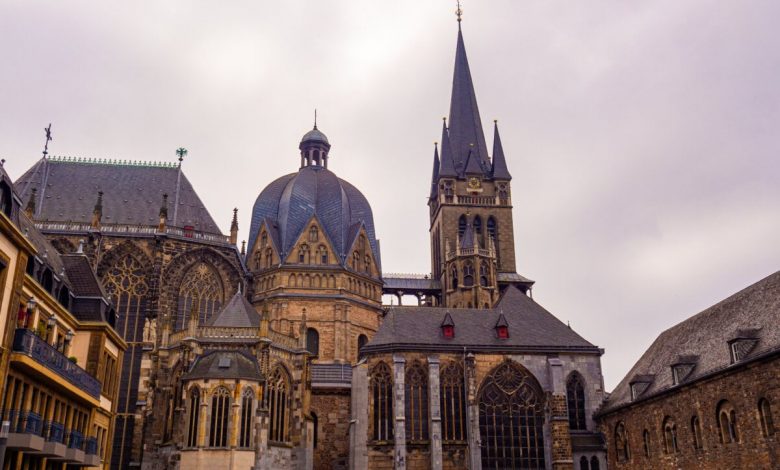Aachen Cathedral: cultural heritage profile

Diplomat.Today
Welcome to our comprehensive travel guide to visiting Aachen Cathedral, a destination known for its unique blend of cultural richness, history and educational value in Aachen, Germany. Here you will find detailed insight into what makes Aachen Cathedral such a unique cultural attraction.
This guide gives you our assessment of the tourist attractiveness of Aachen Cathedral based on a number of important criteria. You can find it below to understand why it is included in our list of cultural sights in Aachen.
Details
Cultural Heritage Profile
Universal appeal and cultural authenticity
Cultural wealth and educational value
Conservation and integrity
Accessibility and visitor engagement
Overall rating: 4.7/5
- Universal appeal and cultural authenticity: Aachen Cathedral, with its mix of Romanesque and Gothic influences, beautifully preserves the cultural essence of medieval Europe. Visitors often describe its intricate architecture and serene atmosphere as captivating, making it a must-see destination. So I rate it at 95/100.
- Cultural wealth and educational value: This cathedral is a treasure trove of educational opportunities. Its historical significance as a coronation site for German kings and resting place of Charlemagne adds enormous cultural depth. Tours provide detailed insight into the history and artistry. That’s why the rating here is a great 98/100.
- Conservation and integrity: The cathedral maintains its historical and architectural integrity through ongoing conservation efforts by organizations such as the Aachener Cathedral Construction and Maintenance Association. Ongoing projects focus on preserving its unique features, such as its mosaics and sculptures. However, accessibility issues lower the score slightly to 92/100.
- Accessibility and visitor engagement: The cathedral is relatively easy to reach, with facilities to suit a variety of visitor needs. Guided tours enhance the visitor experience, although some areas may be challenging for those with mobility issues. Engaging amenities such as gift shops and information centers boost the score to a commendable 90/100.
Historical importance
Aachen Cathedral, also called the Imperial Cathedral, is of great historical importance. Emperor Charlemagne used it as the royal chapel of the Aachen palace at the end of the 8th century. The cathedral served as a coronation church for German kings for more than 600 years, and Charlemagne himself was buried there, adding to its historical gravity.
Cultural importance
Aachen Cathedral is a cultural icon not only in Aachen but also in Europe. It has influenced local traditions and art, with Carolingian architecture inspiring subsequent buildings. The cathedral’s status as a UNESCO World Heritage Site further underlines its cultural significance, attracting international visitors and fostering a sense of pride within the local community.
Architectural style
The architectural style of the cathedral is predominantly Carolingian, with later additions reflecting Romanesque and Gothic influences. The octagonal plan and the Palatine Chapel within the complex are notable examples of early medieval architecture. The Shrine of Charlemagne, built in 1215, is a striking feature that contributes to the cathedral’s unique design elements.
Visitor experience
Visitors to Aachen Cathedral can expect a fascinating experience. Guided tours provide insight into its historical and architectural significance, while special exhibitions often showcase the cathedral’s rich heritage. The serene atmosphere allows for quiet contemplation and appreciation of the cathedral’s splendor.
The cathedral is accessible to a variety of groups, including families and people with disabilities, with ramps and accessible toilets. Additionally, amenities such as cafes and gift shops enhance the visitor experience and provide opportunities to relax and purchase souvenirs.
Ratings and reviews
Aachen Cathedral is highly praised for its historical significance, architectural beauty and cultural resonance. Visitors often praise the peaceful atmosphere and informative tours. However, some reviews point to limitations in accessibility for people with mobility problems. Overall, Aachen Cathedral stands out as a top cultural attraction in the region.
Photographic possibilities
Photographers will find countless fascinating spots in and around Aachen Cathedral. The intricately designed interior, including the Palatine Chapel, and the exterior with the cathedral’s iconic domed structure provide excellent photo opportunities. Visits at sunset and early morning are recommended to capture the cathedral in the best light.
Global influence
- Aachen Cathedral, also known as the Aachener Dom, is recognized worldwide as the first site in Germany to be included on the UNESCO World Heritage List in 1978, recognizing its special architectural and historical significance (Aachener Dom – UNESCO Welterbe).
- The cathedral attracts many international visitors and contributes to the tourism sector in Aachen. It is a prominent destination for tourists interested in medieval architecture and religious history and attracts visitors from all over the world.
- The architectural and historical significance of the cathedral has had a profound influence on global culture, especially in the fields of art, architecture and religious studies. Its unique Carolingian architecture and historical importance make it a subject of study and inspiration for artists, architects and historians around the world.
- Aachen Cathedral has been involved in international events and collaborations, symbolizing cultural exchange and historical dialogue. It has been a focal point for academic and cultural exchanges and contributed to international understanding and cooperation in heritage conservation and historical research.
Historical impact
- Aachen Cathedral played an important role in the history of the Holy Roman Empire, as it was the coronation church for German kings and emperors for more than 600 years, from 936 to 1531.
- Its architectural and archaeological significance lies in the fact that it is one of the best preserved buildings from the Carolingian period, with exceptional craftsmanship and design from the early Middle Ages (A place of history – Aachener Dom).
- The cathedral’s contributions to local and national history are profound. It symbolizes the power and influence of Charlemagne, who chose Aachen as his main residence and established it as the center of his empire. It remains a symbol of the Carolingian Renaissance and Aachen’s historical significance as a political and cultural center in Europe.
- Notable historical figures associated with Aachen Cathedral include Charlemagne, the great Frankish king, who ordered the construction of the Palatine Chapel, which forms the core of the current cathedral and played a crucial role in shaping of the historical and cultural significance of the cathedral.
Conservation efforts
- Current conservation projects for Aachen Cathedral aim to preserve and restore its architectural elements, including its unique mosaics, sculptures and historic structures, ensuring the long-term preservation of this cultural heritage.
- Organizations such as the Aachen Cathedral Construction and Maintenance Association (Dombauhütte) are actively involved in the preservation of the cathedral, overseeing restoration projects and conservation efforts to protect its historical and architectural integrity.
- Funding and support for conservation comes from a variety of sources, including government grants, private donations and international partnerships, reflecting collective efforts to ensure the sustainable conservation of this iconic cultural monument.
- The local community is actively involved in conservation through volunteer programs, educational initiatives and public involvement. It promotes a sense of ownership and pride in the preservation of the cathedral and promotes awareness of its historical significance among residents and visitors.
About

Aachen Cathedral, often called Charlemagne’s Palatine Chapel, is a remarkable example of Carolingian architecture. Known for its octagonal design, this iconic structure was built between 794 and 810. At the time, it was the tallest domed building north of the Alps, showing the influence of Byzantine architecture.
Charlemagne imagined that the cathedral would serve multiple purposes. While it was undoubtedly a place for the ruling family and court, he also intended it to function as a collegiate church, fostering a strong community of clergy. In addition, it served the local population as a parish church.
From 936 to 1531, Aachen Cathedral played an important role in the coronation ceremonies of German kings and became the episcopal church of the diocese of Aachen. Since the 13th century, it has also become an important pilgrimage site, attracting countless visitors seeking spiritual solace and historical insight.




